Crysis 3
Crysis 3 is a first-person shooter video game developed by the German game developer Crytek and is published by Electronic Arts (EA) for Microsoft Windows, PlayStation 3, and Xbox 360. It was released in North America on February 19, 2013. Twenty-four years after the events of Crysis 2, Psycho finds Lawrence “Prophet” Barnes aboard the Liberty Dome in New York City. Joining with Psycho and his team of elite Nanosuit soldiers, Prophet travels around the world looking for the Alpha Ceph, the ultimate Ceph leader, from the knowledge he gained about Ceph. One by one his teammates lose interest in the hunt believing that all Ceph are destroyed, until Prophet and Psycho finally trace the Alpha Ceph in Russia and imprison it. Wikipedia
- Very High
- Antialiasing – FXAA
- Texture Resolution – Very High
- V-Sync – No
Crysis 3 is a very intense game and at 5K is going to seriously challenge any GPUs:
Nvidia has a real lead in every setup here. However beyond that it also fairs better with respect to minimum FPS particularly with 3 GPUs.
If we now look at scaling we can see that both manufacturer’s do very well here. This is usually the case whenever FPS is this low – scaling generally is worse once over 60FPS:
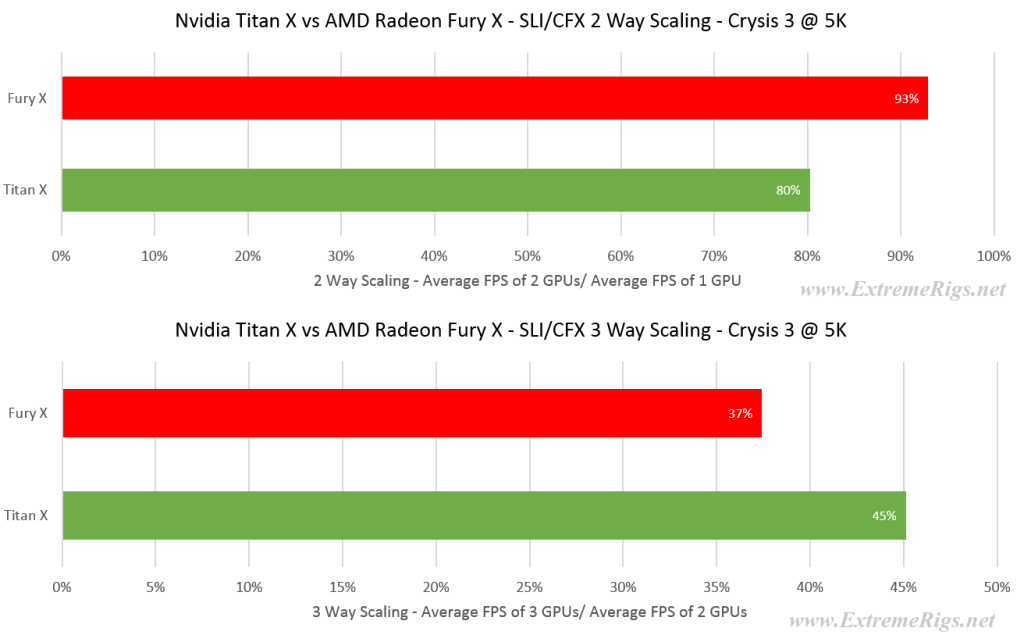 Let’s take a look at max VRAM usage:
Let’s take a look at max VRAM usage:
While both AMD and NVidia use similar amounts of VRAM – Nvidia seems to use more as the number of GPUs increase while AMD is the opposite. AMD might be managing VRAM better by only loading each card with the textures it needs.
Finally let’s take a look at the benchmark runs vs time and make sure there is nothing strange:
The first thing we notice here is that the GPU is fully loaded as you would expect – however there are two ugly spikes. FPS is relatively consistent and there is no indication of any CPU throttling (as you’d expect).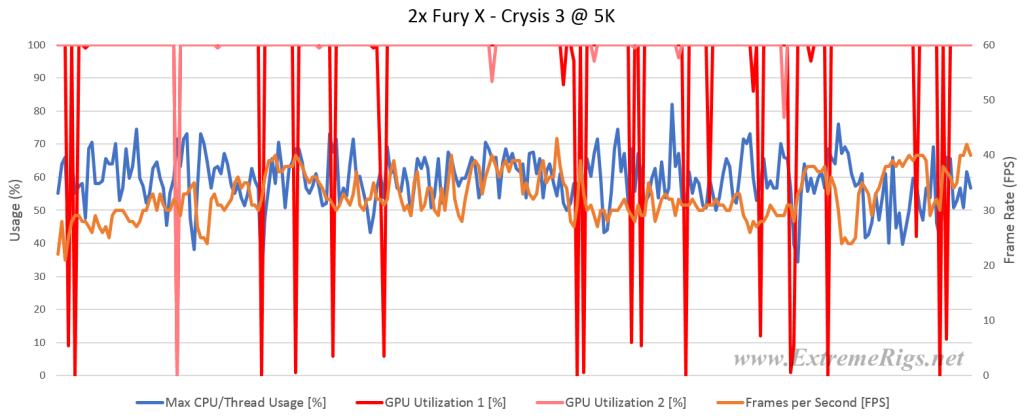 With 2 Fury X cards the 0% usage spikes of the GPUs continues to grow even though they don’t appear to be affecting FPS.
With 2 Fury X cards the 0% usage spikes of the GPUs continues to grow even though they don’t appear to be affecting FPS.
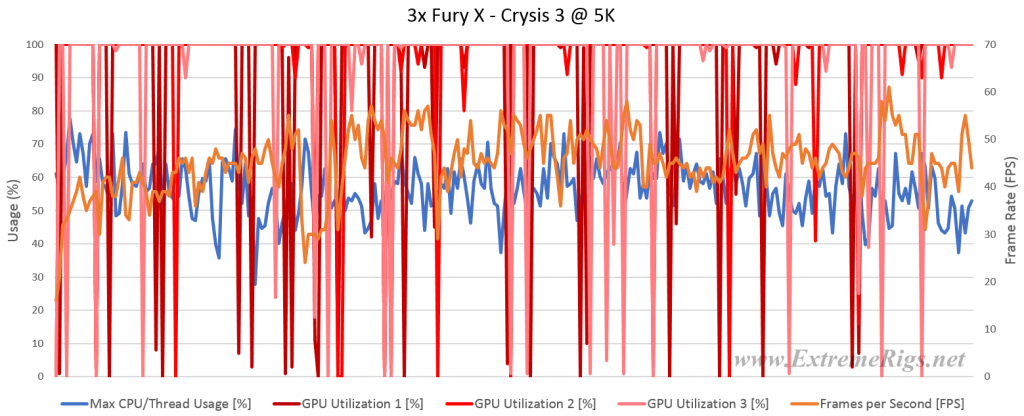
With 3 Fury X cards the load dropouts became extremely prevalent. Nvidia’s Titan on the other looked far smoother:
Interestingly the 2nd GPU was maxing out on load and the 1st GPU would only be used at about 95%. Again there are no definite signs of throttling.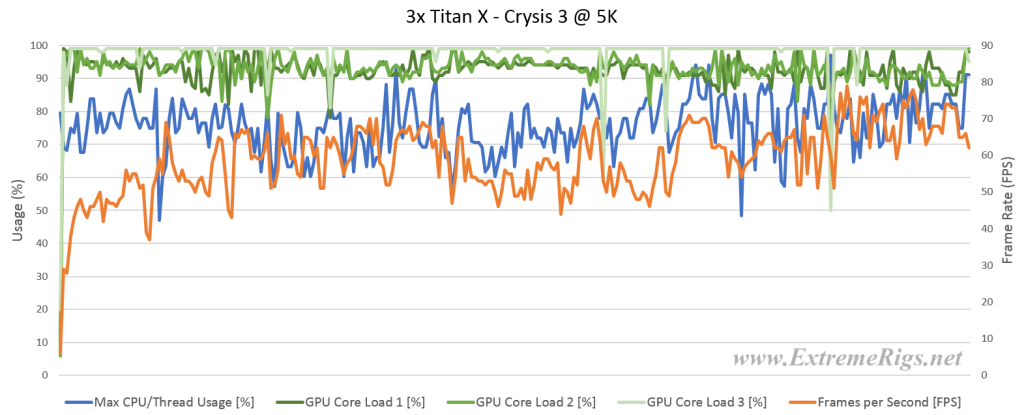 With 3 Titan X’s the loading plots are showing some minor dropouts – but nothing near the scale of the Fury X cards. Again one card gets maxed out while the other two run at a lower usage percentage. This experience did translate to the display where the Nvidia experience was perceived as smoother than AMD’s regardless of FPS.
With 3 Titan X’s the loading plots are showing some minor dropouts – but nothing near the scale of the Fury X cards. Again one card gets maxed out while the other two run at a lower usage percentage. This experience did translate to the display where the Nvidia experience was perceived as smoother than AMD’s regardless of FPS.
In summary if you really want to play Crysis 3 smoothly at 5K on high settings you’re going to need 3 Titan X’s.









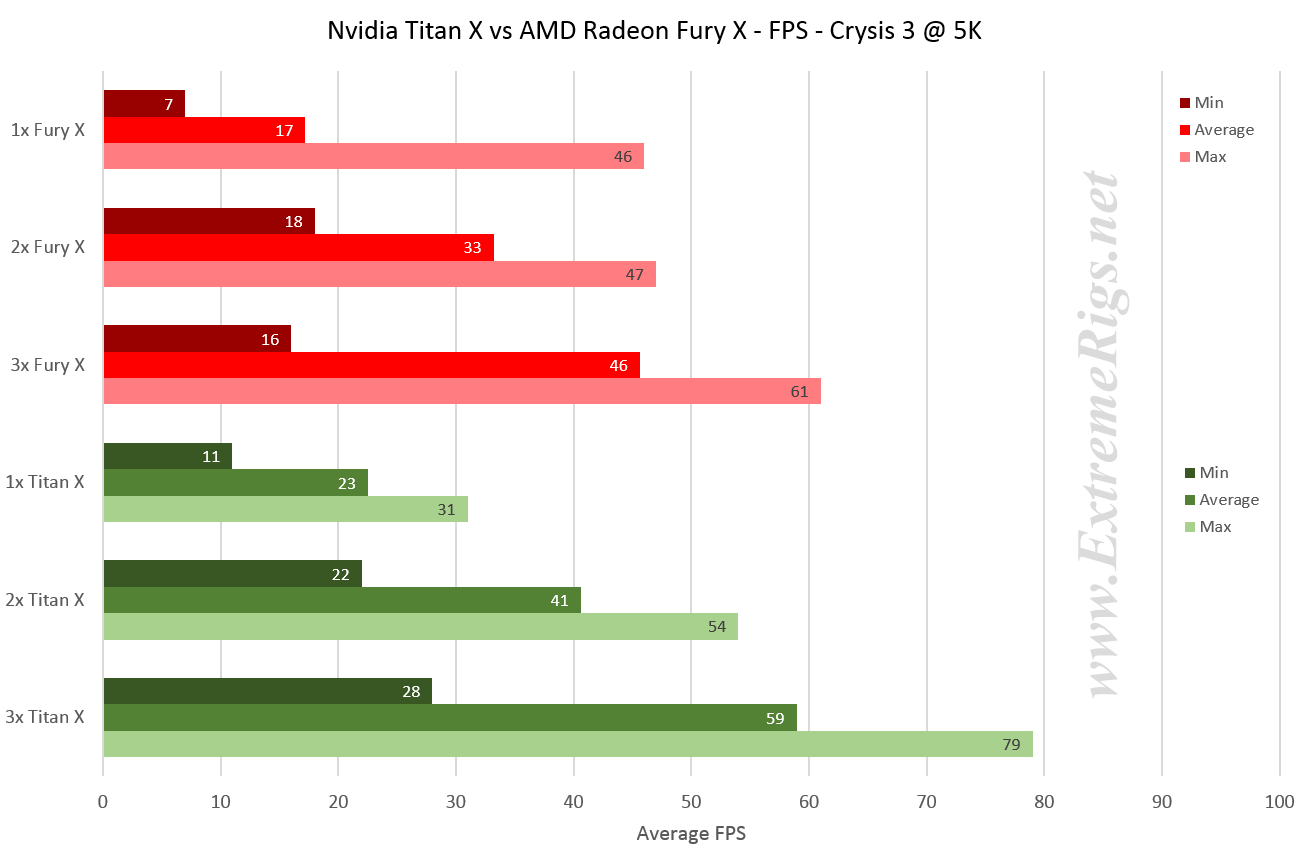
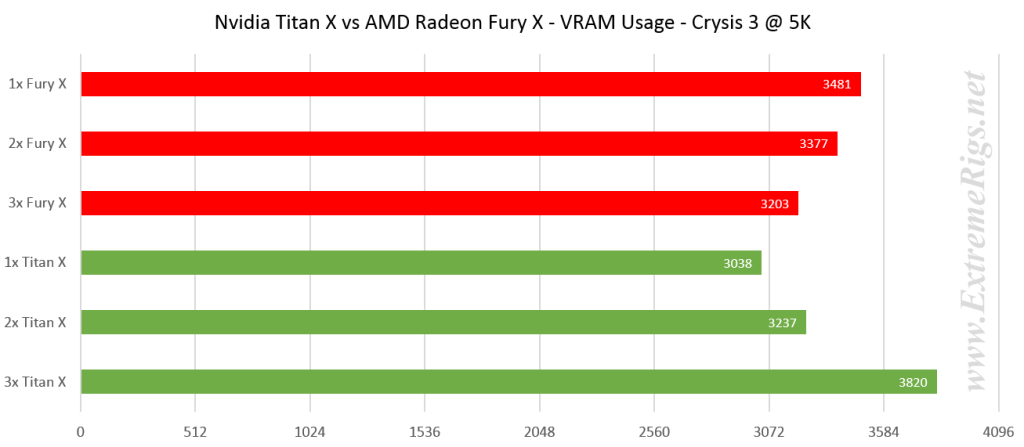
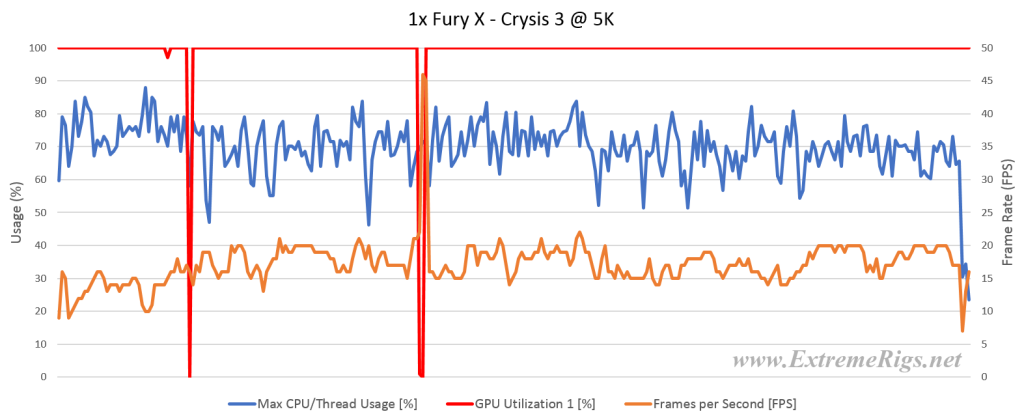
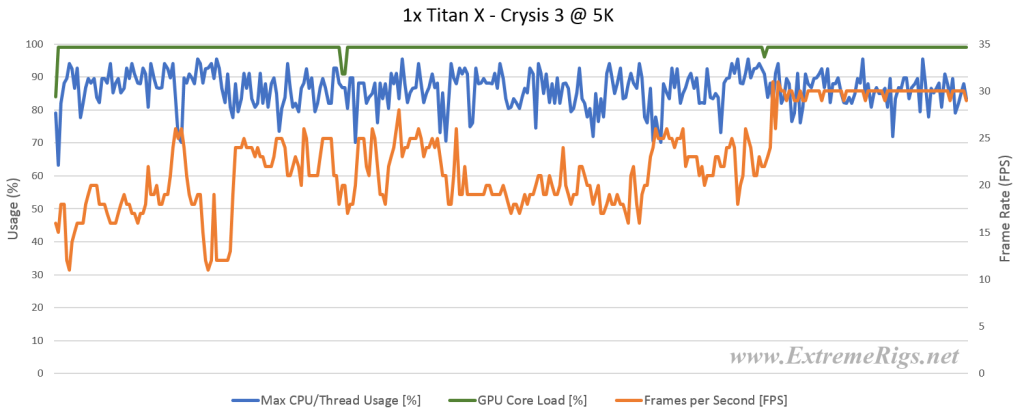
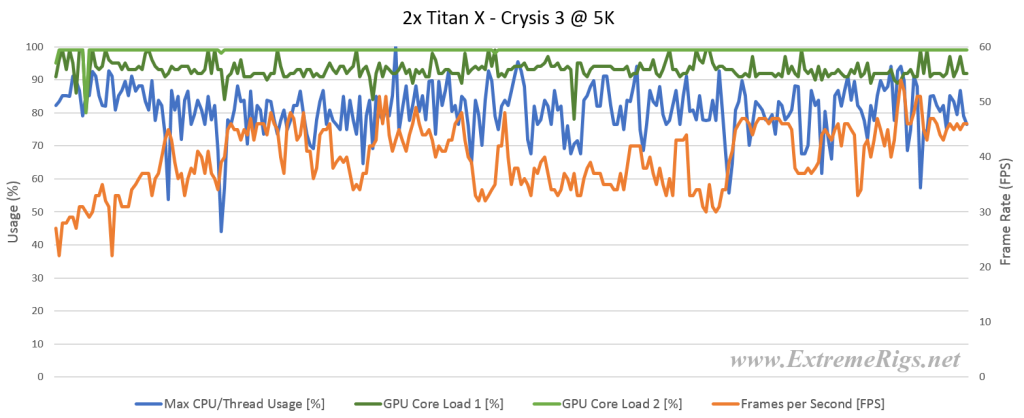





To be honest, I started reading this article with a thought that “well, how good can it be? ERs are watercooling guys so, nah! can’t expect too much”. But after reading the whole of it, I have to say, This is by far the one of the best comparative reviews I’ve ever seen, and really met all my expectations. Hats off to you guys!
Say, FuryX did have the claim in its pre-release rumor to be a TITAN X competitor, but then AMD shrunk that note to 980 Ti. So I think comparison with 980 Ti would’ve been better comparison (and seat clenching brawl) than this, and the clock-to-clock performance metrics but nonetheless, this is wayy too good also!
About capping the vRAM on FuryX in few games there, it also suffers from similar performance degradation on 4K and downwards. And as you may have seen on other reviews, FuryX does worse in sub-4K than the competition and even worse in 1080p. I’ve dug through every review out there yet haven’t found the reason behind this. What could be the reason?
And that scaling on nVidia – you know nvidia does claim that their SLI bridge isn’t a bottleneck, and so it is proved here :P. When AMD did introduce XDMA, I had this belief – AMD took the right path, bridges will suffer from less bandwith sooner or later, and PCIe already has the room for accommodating the data of the bridges. So XDMA did (well, now it is “do” :D) makes sense!
But it’s sad to see AMD not delivering smoother experience overall. If they could handle that thing, this should certainly deserved the choice over any of those higher average FPS of Titan X. But I think AMD is working on Win10 & DX12 optimized drivers and trying to mend it with bandages for now.
My only complain was the choice of TitanX over 980 Ti and clock-to-clock performance, but other than this, this is a very great review! Hats off to you again!
Agreed with Frozen Fractal. I was more than pleasantly surprised with the quality of this review, and I hope you continue to do these more in the future. A 980 Ti would have been nice to see too given the price.
Keep up the great work!
Thanks! I agree the 980 TI would have been a better comparison – then prices would have lined up. “Sadly” we only had Titan X’s and we weren’t willing to go out and buy another 3 GPUs to make that happen. However if anyone wants to send us some we’d gladly run em haha. I was simultaneously impressed with AMD’s results while saddened that after all the work on frame pacing that things still aren’t 100% yet. Hopefully
Question…you overclocked the Titan X to 1495MHz which is “ok” for a water cooling build. I won’t complain…though I’m surprised at why that’s all you were able to achieve as I can pull that off on Air right now (blocks won’t arrive until next week). Main question though…why wasn’t the memory overclocked? A watercooled Titan X has room to OC the memory by 20%, bumping up the bandwidth to 400Gbps, which brings it quite a bit closer to the 512Gbps of the HBM1 in the Fury X.
Although we didn’t mention it the memory was running a mild OC at 7.4Gbps up from the stock 7gbps
6gbps – so yes about the same as your 20%
This is what concerns me about your understanding of overclocking. The Titan X memory is 7GHz at stock. At 7.4GHz you’re only running a 5.7% OC on the memory…
Hah you’re right, I was looking at titan stock memory settings not titan x. Yes it could have been pushed harder. Still though single Titan X was really good compared to Fury X – the issue it had was scaling. So unless scaling is significantly effected by memory bandwidth then I don’t think it changes the overall results much. When we re-run with overclocked furies we’ll spend a bit more time on the Titan X overclock too.
Don’t get me wrong…SLI scaling is definitely an issue and will still exist regardless. But you’d be surprised how important memory clocks can be depending on the test you’re running. I found this out when I was running the original GTX Titan Tri-Sli in the overclock.net unigine valley bench competition and came in second place. Leave the official redo for your next review of Fury X OC vs Titan X OC, as you mentioned. But to satisfy your own curiousity, try a higher memory clock and see what happens. If you were looking to squeeze out every last ounce out of your Titan X, you should check out http://overclocking.guide/nvidia-gtx-titan-x-volt-mod-pencil-vmod/ as well.
My Phobya nanogrease should be coming in tomorrow so I’ll finally be putting my blocks on as well. I’m going to compare my performance results with yours next time you run your benches. So make sure you do a good job.
Excellent review. I am also running an Asus Rampage Extreme V with a 5960x OC’d to 4.4Ghz so your data really was telling. I’m running a single EVGA GTX980TI SC under water. I previously ran 2 Sapphire Tri-X OC R9 290s under water but opted to go with the single card.
Did you use a modded TitanX bios? What OCing tool did you use to OC the TitanX. I would like to try to replicate the parameters and run the single 980TI to see how close I am to your single TitanX data. Thank you.
Eh, i don’t really see the point of running AA in 5K Too bad it’s 5K btw, 4K is more reasonable. Too bad Fury X has problems with the Nvidia titles(W3 for example).
Too bad it’s 5K btw, 4K is more reasonable. Too bad Fury X has problems with the Nvidia titles(W3 for example).
But man, the scaling and texture compression on amd cards are absolutely amazing. If only they weren’t bottlenecked by the HBM1’s 4GB of VRAM.
[…] Review: Titan X vs Fury X in a Triple CFX SLI Showdown […]
[…] Review: Titan X vs Fury X in a Triple CFX SLI Showdown […]
[…] Review: Titan X vs Fury X in a Triple CFX SLI Showdown […]
Comments are closed.